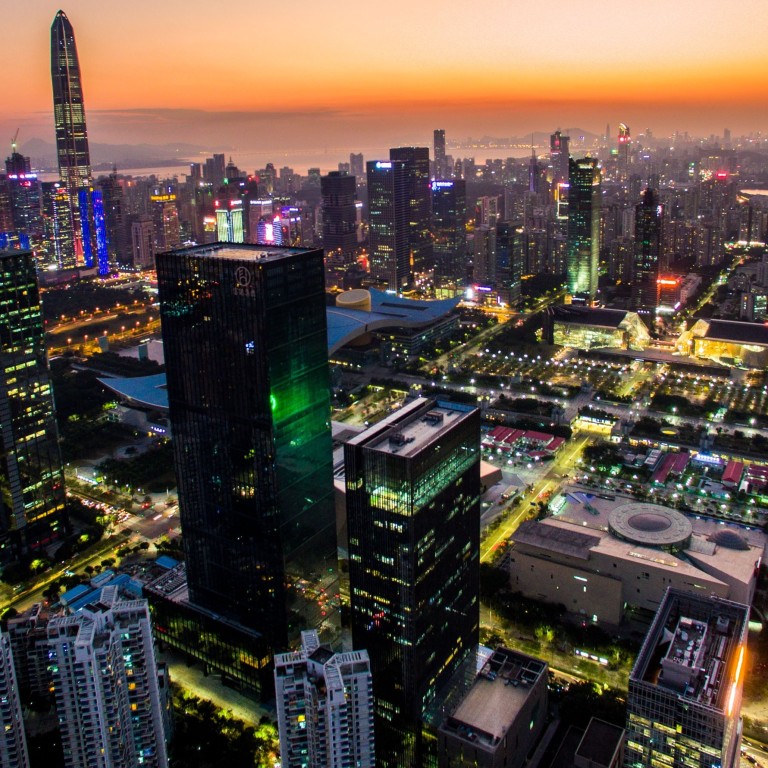
Shenzhen growth rate falls sharply in third quarter as US trade war weighs on China’s hi-tech hub
- The growth rate for the home city of Huawei and Tencent slowed to 6.6 per cent in the first nine months of 2019 from 7.4 per cent in the first half of the year
- Exports dropped 9.3 per cent, while the private sector investment rate plummeted to only 0.3 per cent, underlining the impact of the US trade and tech wars
The growth rate in Shenzhen, China’s hi-tech hub, slid to its lowest level in 40 years during the first nine months of the year, underlining the impact of the trade and tech wars with the United States.
The city’s growth rate is seen as a key indicator for the overall economy, given it is home to some of the nation’s biggest hi-tech champions, such as Huawei and Tencent.
Shenzhen’s economy grew 6.6 per cent between January and September compared to a year earlier, the lowest growth rate since the city became a special economic zone in 1979, according to official data.
This indicated a sharp deceleration in the third quarter with the growth rate for the January to September period falling from the 7.4 per cent rate in the first half of the year. Shenzhen did not publish a growth rate for the third quarter alone.
The growth slowdown was led by a plunge in private investment growth, which fell to only 0.3 per cent in the January to September period compared to a year earlier from the 12.3 per cent rate posted in the first half of the year.
Shenzhen’s slowdown, coupled with Hong Kong slipping into recession after its economy shrunk 3.2 per cent in the third quarter following a 0.4 per cent drop in the second quarter, offers a bleak picture for the two largest components of the Greater Bay Area development plan.
The toll of the trade war and the overall slowdown in the world economy were evident in the latest data, with exports dropping 9.3 per cent in the first three quarters compared to a year earlier, although imports still grew by 4.8 per cent.
The government needs to launch further measures to stabilise industrial and private sector investment and prevent a sustained exodus of manufacturing enterprises in traditional and technology fields from Shenzhen due to soaring costs
“We have seen a sharp drop in imports. On the one hand, it might be because Shenzhen’s enterprises are reluctant to expand production and so reduced imports of production materials. On the other hand, it might be because the United States reduced exports of hi-tech products and equipment to Shenzhen technology companies.” said Guo Wanda, vice-president of the China Development Institute, a Shenzhen-based think tank.
“Investment and consumption also fell sharply. The government needs to launch further measures to stabilise industrial and private sector investment and prevent a sustained exodus of manufacturing enterprises in traditional and technology fields from Shenzhen due to soaring costs.”
Guo said it is difficult to estimate the outlook for the fourth quarter, saying only that he expected Shenzhen’s hi-tech enterprises to continue their spending on research and development for the adaptation of new technologies including 5G communications.
Despite the sharp deceleration in private sector investment, total fixed-asset investment grew 17.9 per cent in the first three quarters, thanks to government-led infrastructure projects, which saw a 43.8 per cent increase.
But private consumption growth also slowed during the January to September period, with the growth rate dropping to 6.8 per cent from 7.7 per cent in the first half of the year.
Production growth at large industrial firms – companies with annual revenue exceeding 20 million yuan (US$2.9 million) from their main businesses – slowed to 5.3 per cent in the first three quarters from the 7.4 per cent recorded in the first six months, with output growth decelerating in all hi-tech sectors. Advanced manufacturing growth slowed to 7.2 per cent from 10.3 per cent in the first half of the year, while hi-tech manufacturing growth rose 8.1 per cent, down from 11 per cent in the first half.
We industry insiders have been saying that business has been difficult [recently], but we are still very surprised by Shenzhen’s GDP data. seems to be ironclad proof telling us the economy is really bad
“We industry insiders have been saying that business has been difficult [recently], but we are still very surprised by Shenzhen’s GDP data,” said Cindy Huang, a veteran saleswoman of high-end serviced offices in Shenzhen’s central business district. “It seems to be ironclad proof telling us the economy is really bad.”
Huang added that there has been growing pressure on office landlords in Shenzhen to cut rents because of the high vacancy rates in many of the high-end office buildings.
Overall, more than one-third of China’s provinces failed to meet this year’s growth targets during the first three quarters, with official data showing that traditionally poorer regions suffering the most, while the wealthier coastal provinces were more resilient.
Guangdong, China’s most prosperous province last year that includes the city of Shenzhen, grew 6.4 per cent in the first three quarters of 2019, meeting its growth target and marginally surpassing the national rate of 6.2 per cent.
“Because of both the trade war and the current tightening of the political climate … many domestic entrepreneurs are facing new risks and difficulties in their operations,” said a Guangdong-based expert with close ties to the provincial government but who spoke on condition of anonymity.
“Local officials have become cautious and are not willing to promote solid economic reforms. It is difficult to measure the direct [economic] loss results from these factors, but the impact is huge and long-term.”
“So far, few Hong Kong-invested projects have been postponed or relocated out of Guangdong because of [the protests].” he added.

